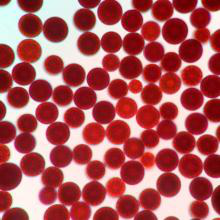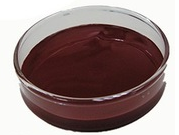2017 wholesale price Astaxanthin Factory for Macedonia
2017 wholesale price Astaxanthin Factory for Macedonia Detail:
[Latin Name] Haematococcus Pluvialis
[Plant Source] from China
[Specifications]1% 2% 3% 5%
[Appearance] Dark red Powder
[Particle size] 80 Mesh
[Loss on drying] ≤5.0%
[Heavy Metal] ≤10PPM
[Storage] Store in cool & dry area, keep away from the direct light and heat.
[Shelf life] 24 Months
[Package] Packed in paper-drums and two plastic-bags inside.
[Net weight] 25kgs/drum
Brief Introduction
Astaxanthin is a natural nutritional component, it can be found as a food supplement. The supplement is intended for human, animal, and aquaculture consumption.
Astaxanthin is a carotenoid. It belongs to a larger class of phytochemicals known as terpenes, which are built from five carbon precursors; isopentenyl diphosphate and dimethylallyl diphosphate . Astaxanthin is classified as a xanthophyll (originally derived from a word meaning “yellow leaves” since yellow plant leaf pigments were the first recognized of the xanthophyll family of carotenoids), but currently employed to describe carotenoid compounds that have oxygen-containing moities, hydroxyl or ketone , such as zeaxanthin and canthaxanthin. Indeed, astaxanthin is a metabolite of zeaxanthin and/or canthaxanthin, containing both hydroxyl and ketone functional groups. Like many carotenoids, astaxanthin is a colorful, lipid-soluble pigment. This colour is due to the extended chain of conjugated (alternating double and single) double bonds at the centre of the compound. This chain of conjugated double bonds is also responsible for the antioxidant function of astaxanthin (as well as other carotenoids) as it results in a region of decentralized electrons that can be donated to reduce a reactive oxidizing molecule.
Function:
1.Astaxanthin is a powerful antioxidant and may protect against oxidative damage to body tissues.
2.Astaxanthin can improve the immune response by increasing the number of antibody producing cells.
3.Astaxanthin is a potential candidate to treat neurodegenerative disease such as Alzhimer and Parkinson diease.
4.Astaxanthin dan reduce UVA-light damage to skin such as sunburn, inflammation, ageing and skin cancer.
Application
1.When applied in pharmaceutical field, astaxanthin powder has the good function of antineoplastic;
2.When applied in health food field, astaxanthin powder is used as food additives for pigment and health care;
3.When applied in cosmetic field, astaxanthin powder has the good function of antioxidant and anti-aging;
4.When applied in animal feeds field, astaxanthin powder is used as animal feed additive to impart coloration, including farm-raised salmon and egg yolks.
Product detail pictures:

Related Product Guide:
Our firm aims to operating faithfully, serving to all of our shoppers , and working in new technology and new machine consistently for 2017 wholesale price Astaxanthin Factory for Macedonia , The product will supply to all over the world, such as: Czech, Zurich, Cannes, Strong infrastructure is the need of any organization. We are backed with a robust infrastructural facility that enables us to manufacture, store, quality check and dispatch our products worldwide. To maintain smooth work flow, we have sectioned our infrastructure into a number of departments. All these departments are functional with latest tools, modernized machines and equipment. Owing to which, we are able to accomplish voluminous production without compromising upon the quality.
Subscribe Now:
https://www.youtube.com/subscription_center?add_user=Ehowhealth
Watch More:
https://www.youtube.com/Ehowhealth
Making an odorless garlic isn’t actually something that you can do at home. Find out how the professionals make an odorless garlic with help from a board-certified naturopathic doctor and a licensed acupuncture physician in this free video clip.
Expert: Ahuva Gamliel
Bio: Ahuva Gamliel is a board-certified Naturopathic Doctor and a licensed Acupuncture Physician.
Filmmaker: Michael Watkins
Series Description: You can use a lot of great, natural remedies to treat many common illnesses and conditions right in your very own home. Learn about using natural remedies safely and efficiently with help from a board-certified naturopathic doctor and a licensed acupuncture physician in this free video series.
For information, pictures and swatches check my blog post: https://istylenotes.com/2015/10/07/dr-hauschka-lip-balm/
The official blurb:
Intensive soothing care for dry, chapped lips, this rich balm promotes skin renewal as it moisturises and softens. Lip Balm provides a translucent shine and helps visibly reduce fine lines around the mouth. Calendula and St. John’s wort extracts encourage renewal. Silk and anthyllis strengthen delicate lip tissue to give the lips a velvety feel and a long-lasting warm, floral scent. This intensive care results in beautiful, soft lips.
Ricinus Communis (Castor) Seed Oil, Beeswax (Cera Alba), Arachis Hypogaea (Peanut) Oil, Daucus Carota Sativa (Carrot) Root Extract, Anthyllis Vulneraria Extract, Prunus Armeniaca (Apricot) Kernel Oil, Calendula Officinalis Flower Extract, Helianthus Annuus (Sunflower) Seed Oil, Theobroma Cacao (Cocoa) Seed Butter, Hypericum Perforatum Flower/Leaf Extract, Silk (Serica) Powder, Triticum Vulgare (Wheat) Germ Oil, Simmondsia Chinensis (Jojoba) Seed Oil, Triticum Vulgare (Wheat) Bran Extract, Lecithin, Fragrance (Parfum), Citronellol*, Geraniol*, Linalool*, Farnesol*, Benzyl Benzoate*, Citral*, Eugenol*, Benzyl Alcohol*, Benzyl Salicylate*.*component of natural essential oils
Products and services are very good, our leader is very satisfied with this procurement, it is better than we expected,







